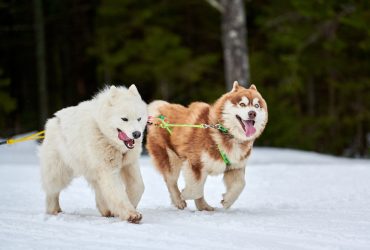The Husky and Samoyed are not what you would consider typical summer dog breeds. Their thick fur coats are more suitable for sled pulling than swimming. However, if you’re on the market for a companion to boost your levels of fun this summer, look no further than these two Siberian relatives. Don’t worry, this Husky vs Samoyed article is not a boxing match between the two breeds. Instead, we will be comparing their personalities so that you’ll know which breed is the best for you.
Table of Contents
The Siberian Bloodline
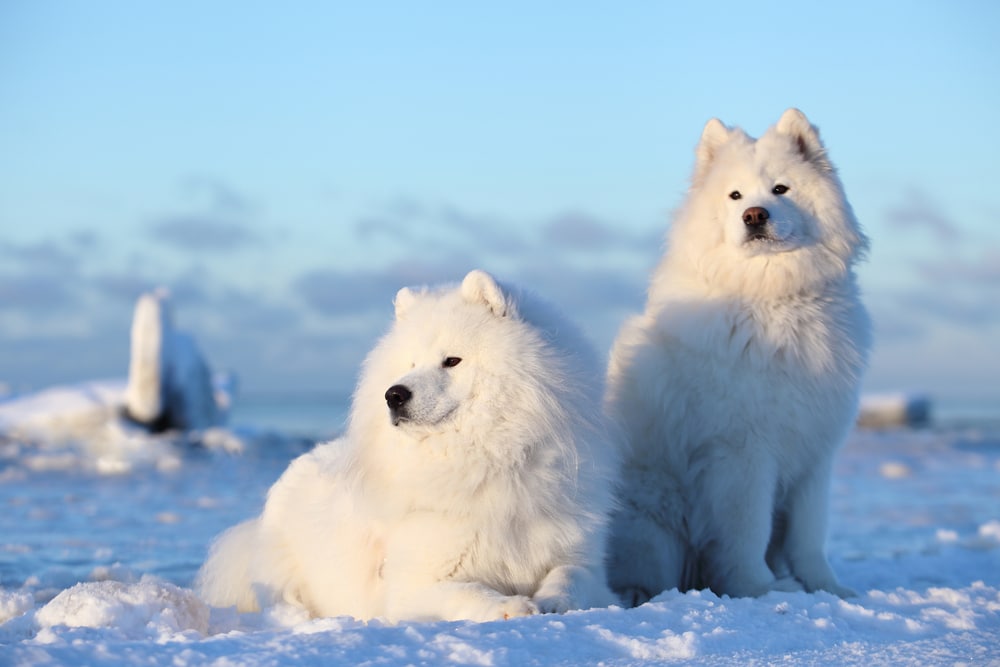
The story of Husky vs Samoyed starts in Siberia. The Samoyed was a sled dog for the Samoyede people. In addition to pulling sleds in the day, Samoyeds were used as blankets to keep the tribe warm at night. Their calm personalities made them excellent livestock herders. The Samoyede people made Samoyeds part of their family. They would often participate in family activities after work hours. This built the Samoyed’s lasting connection to their owners.
Samoyeds are pack animals and they need an alpha lead. When they are not part of a pack, the alpha becomes their owner. And Samoyeds want to spend as much time with their owner as they can. After moving out of Siberia, at the end of the 19th century, Samoyeds became a hit in England, as Queen Alexandra was an enthusiast of the breed.
The Husky, the Samoyed’s Siberian cousin, ran with the Chukchi tribe. Huskies are one of the oldest dog breeds, around long before Samoyeds. With the Chukchi People, Huskies doubled as family pets in addition to sled pullers. Like Samoyeds, Huskies were used as blankets to keep the Chukchi people warm on cold winter nights. During the 1908 Gold Rush, Huskies found themselves working in Alaska. They starred in the all-Alaska sweepstakes, which is a 408-mile long dog sled race. To this day, Huskies are active competitors. Years later, the Husky became popular in North American climates, however, they never forgot their Siberian roots.
Why Have A Husky vs Samoyed Battle When There’s So Much In Common?
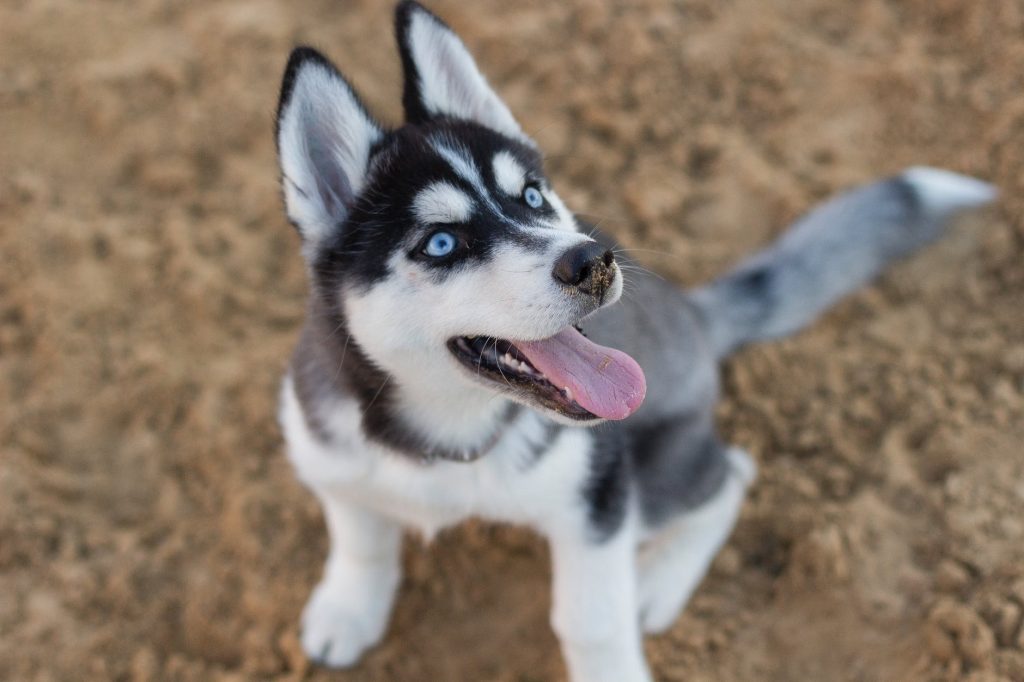
Outside of their Siberian origins, the Husky and Samoyed have a lot in common. Starting with their temperament. As mentioned, the Samoyed needs a strong alpha leader to guide them through life. The Husky also needs a strong alpha. Neither of these breeds is recommended for first-time dog owners. Training is a breeze for both dogs if they have a strong alpha leader to look up to.
However, if you don’t earn the respect of these breeds, then they can be a nightmare to train. The Husky is the more difficult of the two dogs. It will often challenge your position as the alpha leader. For example, getting aggressive during playtime. You cannot lose your cool in these situations. If you do, you lose your spot as the alpha. A good way to solidify your position as an alpha for both breeds is to control their food. Making both breeds wait for their treats and obey commands before receiving rewards is a great alpha technique.
- Proudly made in the USA, 100% of ingredients are sourced in the USA
- Farm-raised American Chicken is the #1 ingredient
- No added poultry by-products; no added corn, soy or wheat, no added artificial flavors
- Feed as a treat; training aid or reward for your dog. Feed as a whole piece or break into half or smaller size bite sized pieces
- Net wt. 6 oz (170 g) of chicken and waffle bites in a resealable bag to preserve freshness
Thick Coats
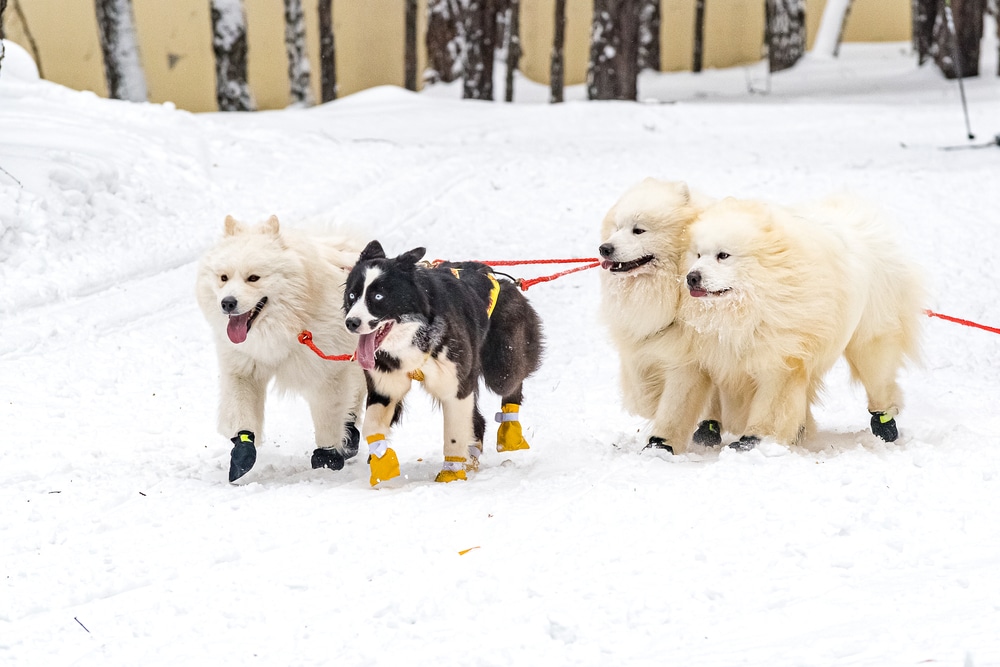
Looking at the Husky vs Samoyed matchup, it’s hard to miss their thick fur coats. Both dogs offer double-layered coats to keep them insulated during the winter. Unfortunately, if you live in a hot climate, this fur will end up all over your house if the dogs are not groomed often. The Samoyed’s coat is cloud-like in color. Its rough overcoat is complemented by a softer second coat.
The Samoyed coat comes in 4 distinct colors including white, cream, biscuit, and white-biscuit. The Husky wears a patterned coat. Its most common look is a white-grey pattern paired with piercing blue eyes. The Husky truly is the movie star of the dog world. Other coat colors for Huskies include grey, pure white, and copper. When you find a Husky with a pure white coat, it’s hard to tell them apart from a Samoyed. Both dogs have wolf-like features and are similar in size.
Lifespan
In terms of lifespan, the Samoyed lives between 12-14 years, and the husky lives between 12-15 years. This all depends on feeding levels, exercise, breeding practices, and a variety of other factors.
Husky vs Samoyed: The Tail Of The Tape. Who’s Bigger?
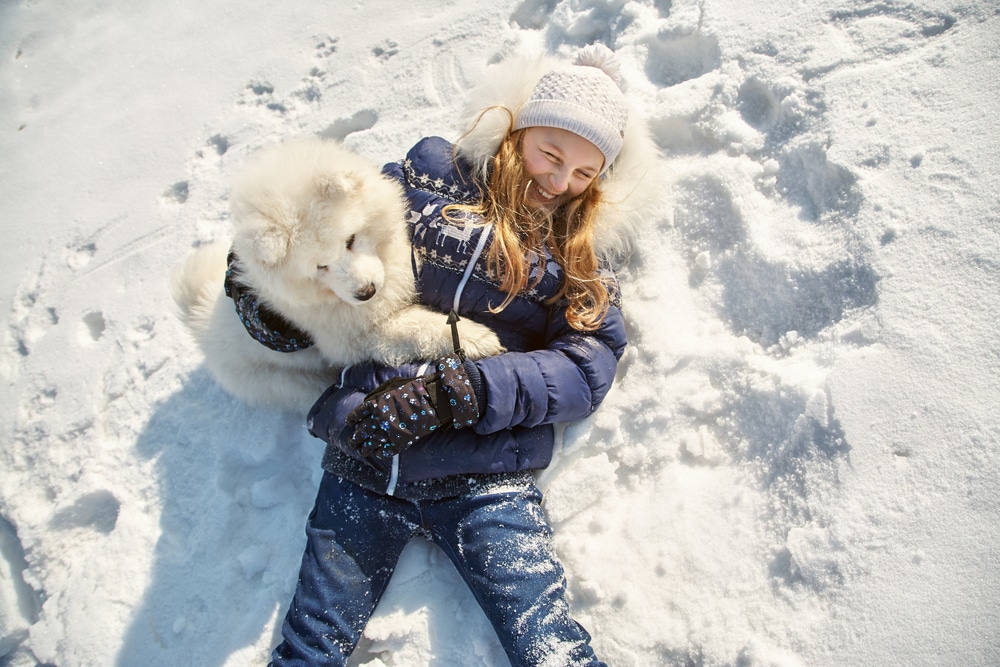
The average male Husky stands 21 to 23.5 inches in height (53 to 60 centimeters). They can weigh around 45 to 60 pounds (20 to 27 kilograms). Female Siberians stand between 20 to 22 inches (51 to 55 centimeters) and weigh about 35 to 50 pounds (16 to 22 kilograms).
According to their growth chart, male Samoyeds stand about 21 to 23.5 inches tall (53 to 60 centimeters) while females are 19 to 21 inches tall (48 to 53 centimeters). Males will weigh 45 to 66 pounds (20 to 30 kg) and females weigh 35 to 45 pounds (15-20 kilograms).
Both breeds are intelligent active medium-sized dogs with virtually no difference in height or weight.
Husky vs Samoyed vs You: Temperament & Training
The Husky has the capacity to be a lone wolf and give you some space when you need it. Even though it belongs with a pack, or close to alpha, it is not as attached to people as its Samoyed cousin. The Samoyed does not have the capacity to leave you alone. They love you and want to be around you all the time. Samoyeds don’t like to be left alone for longer than 4 hours at a time. You are their leader and they get bored when you’re not around.
You don’t want to leave either of these dog breeds unattended when they’re bored. Unexercised Samoyeds and Huskies can get up to massive mischief in your house. They will find ways to keep themselves pre-occupied, and it often involves destroying your personal belongings. For example, don’t be surprised to come home and find a few of your favorite pairs of shoes chewed up or your sofa in shambles. It’s always good to exercise both of these breeds for at least 2 hours per day, especially before heading out.
Samoyeds Love Being Around You
While you might not be thrilled with the Samoyed’s clingy attitude, it’s actually an advantage when it comes to training. Because the Samoyed wants to make you happy, it will listen to your commands and obey them. The Husky on the other hand is not so willing to obey, and it will often challenge your commands. The breed has a mind of its own and it’s very difficult to get them to do something they have no interest in. Here’s an example to show you how mischievous a Husky can be. When enrolled in training classes, a Husky will pretend that they are a “good boy” and follow along with the rest of the class. But when they get home, they will go back to misbehaving.
- Amazon Kindle Edition
- Kane, Karen Douglas (Author)
- English (Publication Language)
- 10/05/2020 (Publication Date)
Building A Pack
A good way to keep these pack dogs in line is to build a pack for them! Huskies thrive in the company of other Huskies, so if you have the opportunity to adopt or buy more than one, take it! Again make sure you are an experienced dog owner, as one Husky on its own is a handful. However, two Huskies will keep each other company for hours on end.
For Samoyeds, we recommend building a family of your own! The Samoyed’s herding instincts make them great with kids. Samoyeds are the ideal dog for a family as someone is almost always home to hang out with them.
Husky vs Samoyed At the Gym
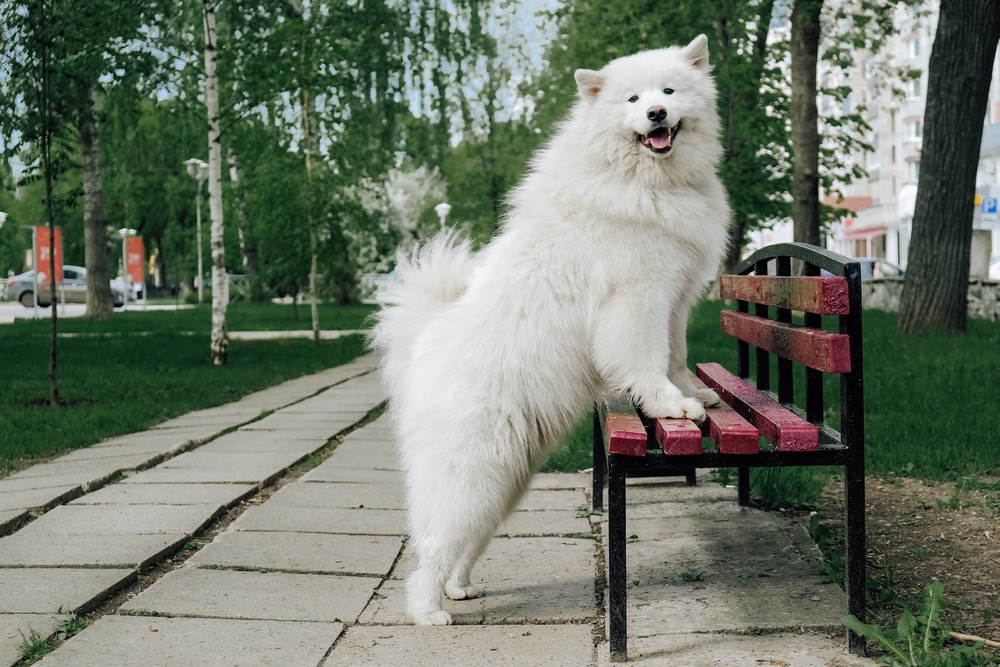
Let’s take the battle of Husky vs Samoyed to the gym! As mentioned, both the Husky and Samoyed love their exercise. Samoyeds need an average of 2 hours of exercise daily. They love going on long walks as the sights and sounds keep them stimulated. Samoyeds should always be on a leash as they have the tendency to explore on their own.
Huskies also love a good jog. They don’t need as much daily exercise as the Samoyed, but they require activities to keep them engaged. Both these breeds are ideal for active families or individuals.
Another thing the Husky and Samoyed have in common: digging! Both these breeds are notorious for digging up your backyard and wreaking havoc in your flower beds. A good solution is to buy or build designated digging spaces for these breeds. Something as simple as a sandbox will do the trick. If you place this designated digging area in your backyard, make sure there’s a fence because both breeds have the tendency to escape and explore the neighborhood.
Time To Eat
The battle of Husky vs Samoyed is definitely not an eating contest. Due to their sled pulling and active nature, neither of these two dogs eats a lot of food. Samoyeds thrive on a raw food diet. And if you do decide to give your Samoyed dry food, make sure it is high in protein. You may find that your Samoyed ignores its dry food. If that’s the case, mix in some meat to build its appetite. Huskies are identical in size to Samoyeds and run on a very similar diet. Again, they prefer raw foods, so you may have to mix some into your Husky’s dry food bowl.
- Real Meat First: Cage-free American chicken is the #1 ingredient; protein helps keep your dog at his bounding best
- No added chicken by-product meal, corn, wheat, soy, artificial colors, flavors, or preservatives
- Added calcium and phosphorus for bones and teeth; support for bones and joints with guaranteed glucosamine; added antioxidants to support immune system; added DHA for brain function
- Formulated with the Help of Veterinarians and a Pet Nutritionist
- Gradual transitioning is important to help avoid dietary upsets. Please see instructions below or on the bag.
So many similarities, what’s the difference?
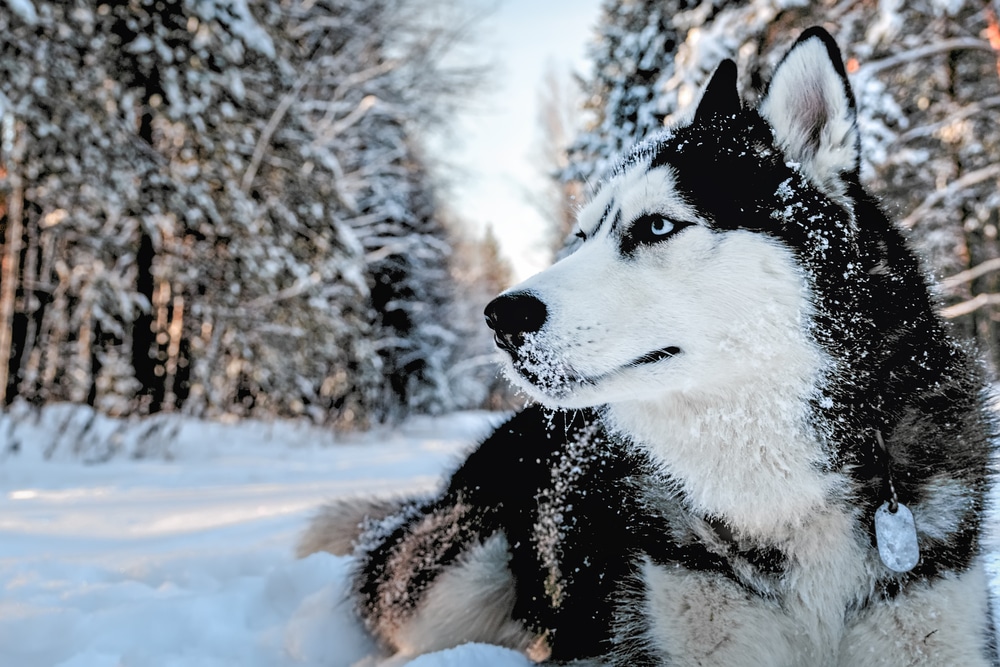
If Husky vs Samoyed were a likability contest, the Samoyed would win. The signature “Samoyed smile” is not just used to hold back drool. They really are happy Samoyeds. They are upbeat dogs who love spending time with people. The Husky is friendly as well, but they can be more aggressive and protective of their territory. The Samoyed is not only kinder than the Husky, but they are also more intelligent. They are the 33rd most intelligent dog breed in the world. To get the most from their intelligence, you’ll need to train them at a young age. While Husky’s are no intellectual slouches, they do not have the same eagerness to please their owner, meaning they’ll use their smarts for their own needs.
This intelligence comes at a price. Samoyeds range in costs from $800 to $1,500 depending on your location, while Huskies range from $800 to $1,000. Samoyeds are currently a very popular breed, so their prices will naturally be higher
In Conclusion
At the end of the Husky vs Samoyed matchup, we’ve discovered that there is nothing for these two breeds to fight about. Both Siberian cousins have their advantages and disadvantages, and it comes down to you, the alpha owner, to decide who your winner is. If you are a well-seasoned dog owner, craving more independence from your dog, then the Husky is the breed for you. If you are a family-oriented active owner who can’t stand being away from your dog, then the Samoyed is for you.
Let us know which Siberian dog breed you prefer in the comment section below!
